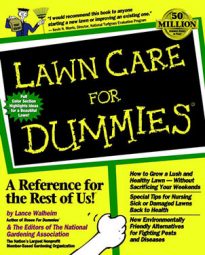There's a fungus among us—or rather, in your lawn. Fungi cause many — in fact, almost all — lawn diseases. To thrive, a fungal disease needs the right plant to infect, the right conditions — temperature, moisture, aeration, and so on — and a way to spread. A fungus’s reproducing spores travel from one place to another, usually through moisture or wind. Spores, however, can even be on the blades of a lawn mower or on the feet of the person pushing it.
That said, take a look at the various factors that influence whether or not your lawn gets a disease.
The type of grass: Any grass that you plant near the edge of or outside its normal range of adaptation is bound to be more subject to disease. The grass just doesn’t grow as well, and that weak growth makes the grass more susceptible.
Even when you plant the right grass in the right climate, some grass types are more likely to get a specific disease than others. Sometimes, all you have to do to prevent diseases from ruining your lawn is to overseed with a less susceptible grass. You also can find some varieties of grass that resist specific diseases. For example, Columbia bluegrass resists patch diseases.
Watering: This element is a biggie. Most lawn diseases thrive in moist or humid conditions. If you water in ways that keep the lawn constantly wet or wet for long periods, your lawn is more likely to have disease problems. Water in the morning so that the lawn dries off quickly afterward. Water deeply but infrequently so that the lawn dries out between waterings.
Temperature: If you live in the desert and you grow a grass that doesn’t like heat, diseases lurk in your future. The same is true for cool climates, if you grow heat-loving grasses. Grow grasses well-adapted to where you live.
Some fungi like the temperature warm; some like it cool. Some, like snow mold, even like it freezing. If you know the conditions in which a certain disease thrives, you can better diagnose the disease and predict when it may occur.
Fertilizing: Some diseases like heavily fertilized lawns; others like underfertilized lawns. Some diseases even prefer a certain soil pH. The point is to apply the recommended amounts of right fertilizer and then make adjustments depending on which problem you have. And don’t forget the value of a soil test.
Mowing: Mowing low creates the grass conditions that disease organisms love: weakened (getting mowed stresses grass) and wounded (mower cuts are the ideal place for the disease to enter). After the disease gets started, you can even spread it around via the mower blades because the disease rides on the blades.
Thatch: Diseases love thatch, that spongy layer of grass stems and debris that forms between the leaves and the roots. Everything about thatch favors fungus. Thatch holds moisture near the surface of the lawn, blocks water and nutrient penetration, and restricts air. Heck, if you were a fungus, you’d love thatch, too. So do something to reduce thatch, such as aerating or power raking.
Pesticide use: Using insecticides and herbicides can upset the natural balance of a lawn, killing off earthworms and other beneficial organisms. Usually, that imbalance results in a thicker layer of thatch.
If you want to avoid diseases, plant the right type of lawn and then take good care of it.

